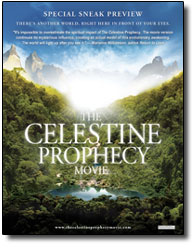| ||
Possessed by coincidence by Judith Reynolds If you rolled your eyes at “The Da Vinci Code,” wait until you see its kid brother. “The Celestine Prophecy” opens at the Abbey Theatre this week. “The Code” has primed a gullible public into a dicey world view. Now it’s time for “The Prophecy” to slip into the back row and pop the corn of fate. Both movies are based on best-selling books. Both have conspiracy on the brain. Both take on the Catholic Church. And both employ conventions as old as the Greeks, most notably a belief that there is no such thing as coincidence. Pay attention, and you’ll meet people, see magic words and/or auras pointing you in the direction of your destiny. Ostensibly set in Peru (but filmed largely in Costa Rica and Florida), “Prophecy” capitalizes on the country’s recent political events. With a corrupt government, rebel insurgents and a powerful Catholic Church, there’s a dubious claim to historical authenticity. Enter junior high school teacher John Woodson (Matthew Settle). He flies to Lima after 1) being laid off, 2) getting a mysterious call from Charlene, an old girlfriend, saying he should go to Peru where Father Jose will show him ancient scrolls that predict the future. That evening, by coincidence, Woodson 3) finds a travel brochure in his mailbox to guess where? 4) There’s one seat available on the next flight to Lima. What a surprise? On the plane, Woodson meets professor Sydney Dobson (archaeologist), who plans to meet Father Jose (priest and archaeologist). That night Dobson and Fr. Jose are both arrested. Another coincidence? Somebody stop me. The point is that everything is meant to be, every decision, every encounter, every turn of events. Why? Because that’s the way the world really works and because the Celestine Prophecy says so.
Rarely has a movie been so over plotted. Rarely has there been so much heavy foreshadowing. Within minutes, you sense the next twist, the next character to suddenly appear out of nowhere – a dense rainforest, a four-star retreat, an Eden-like garden, or a makeshift jungle prison – it doesn’t matter. It’s so predictable, it’s fun. It’s the best bad film I’ve seen in a long time. Following convention, Woodson is an innocent. When he embarks on his spiritual quest, he meets many people. Some are forces for good. His job (“task” in spiritual terms) is to distinguish those who want to help from those who want to kill him. The top contender is Robert Jensen (Jurgen Prochnow). He’s a government hit man posing as, what else, an archaeologist. With his stereotypical Germanic look, high forehead, pale eyes and craggy face, Jensen wastes no time on charm. He threatens Woodson and presses for the whereabouts of the scrolls. (Here’s a bonus: Prochnow also appears in “Da Vinci Code.” What luck. Life really is full of sweet coincidences.) Two other villains include a low-rent, two-star Peruvian general with dreams of dictatorship and Cardinal Sebastian (Hector Elizondo). His slimy excellency betrays the Celestine followers, then prays for forgiveness and waits out the slaughter. Eventually he experiences a dollop of conscience. James Redfield, 56, the therapist-turned-author who conceived this whole scheme, co-wrote the screenplay. His book (1993) was on the New York Times bestseller list for three years. It mixes Eastern and Western philosophies with a quarter cup each of Redfield’s other interests: history, science, mysticism and interactive psychology. The result: alphabet soup. If you taste even a spoonful, you’ll discover whiffs of Freud, Rousseau, M. Scott Peck, Ram Dass, reincarnation, the Rapture and Creationism. You’ll also spot vegetables as familiar as carrots: the guide, the mentor, the soul mate, the shape shifter and the devil. Then at the bottom of the bowl, there are those pesky scrolls. Aren’t ancient documents always authentic? And don’t they always tell the truth? If you believe that, I have an old piece of papyrus in my pantry, and I’m willing to sell it – cheap. •
|


